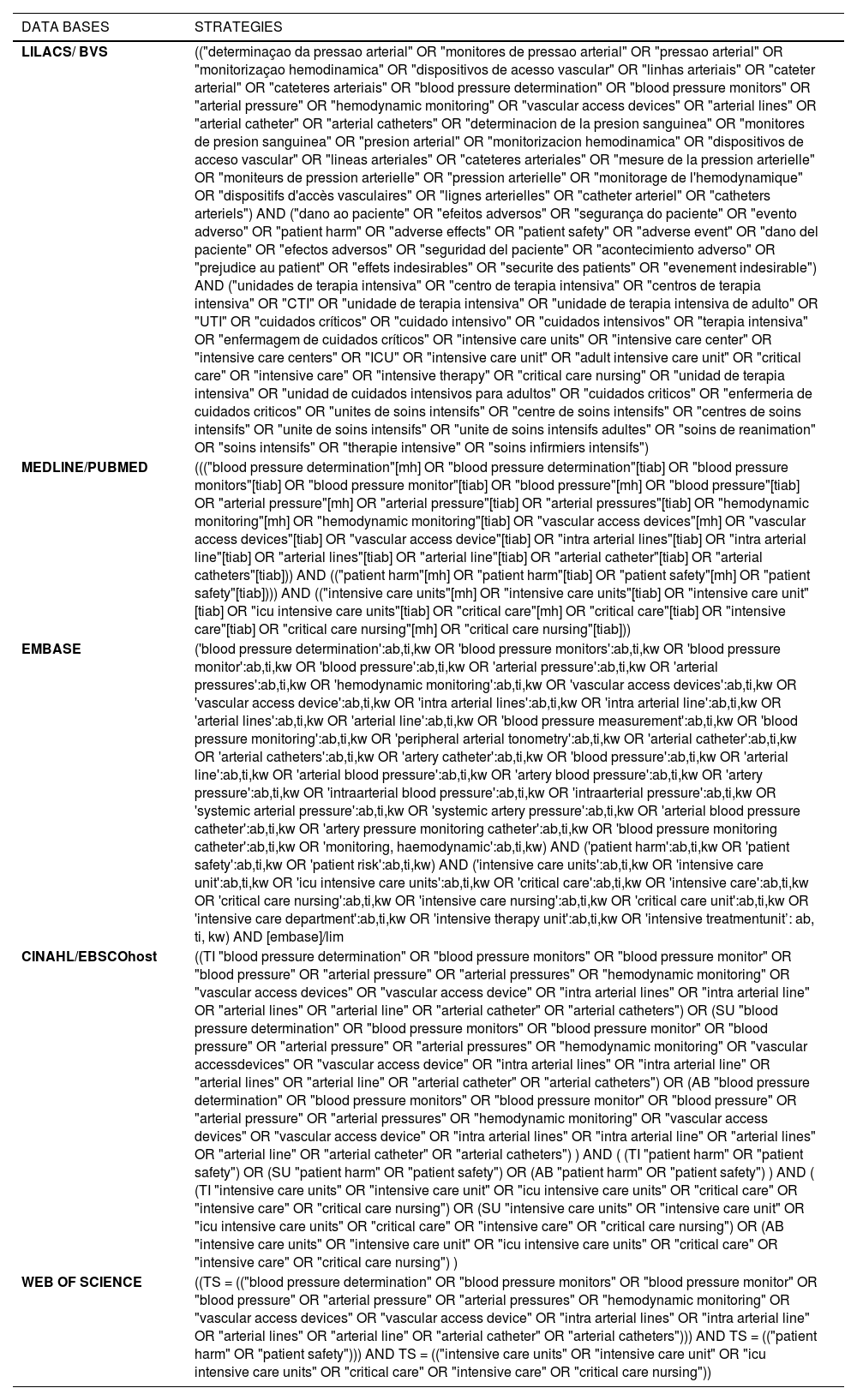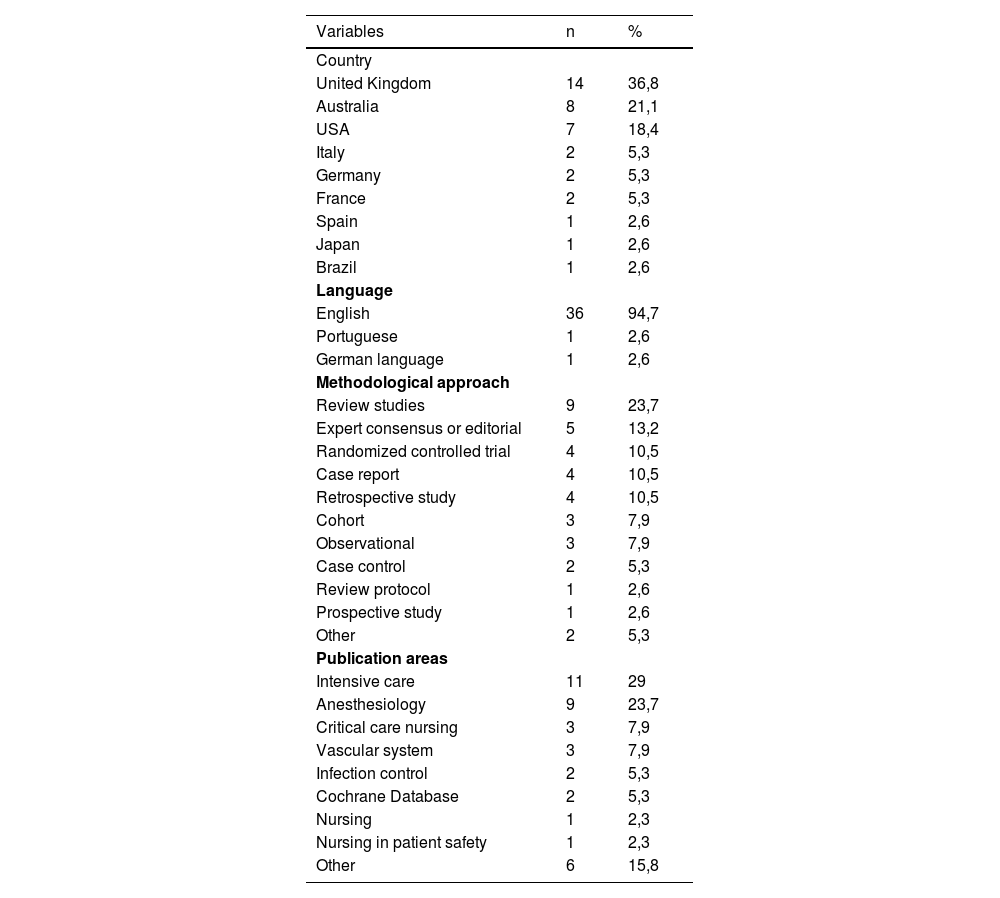The installation of an arterial line is one of the invasive procedures performed for hemodynamic monitoring and, even with its clear importance in intensive care, it is still an invasive procedure and liable to cause harms to the patients.
ObjectiveTo identify the adverse events associated with the use of arterial catheters in critically-ill patients in the world scientific production.
MethodologyThe present scoping review was conducted according to the JBI methodology for scoping reviews. The Preferred Reporting Items for Systematic Reviews and Meta-Analyses extension for Scoping Reviews (PRISMA-ScR) checklist was used for reporting. The research question was “Which adverse events related to the use of arterial catheters in patients admitted to intensive care are more evident in the literature?”. Data collection took place in the following databases: LILACS; MEDLINE; EMBASE; CINAHL, EBSCOhost; and WEB OF SCIENCE.
ResultsThrough the search strategies, 491 articles were found in the databases. After exclusion of duplicates, peer analysis of titles and abstracts, full reading and screening of lists of references, the final sample of studies included was 38 articles. The main harms cited by the publications were as follows: limb ischemia, thrombosis, hemorrhage, accidental removal, inadvertent connection of inadequate infusion solution, pseudoaneurysm and bloodstream infection.
ConclusionsIt was evidenced that patients are subjected to risks of adverse events from the insertion moment to removal of the arterial catheter, focusing on the infusion solution used to fill the circuit, the type of securement and dressings chosen, as well as the Nursing care measures for the prevention of bloodstream infection.
La instalación de una vía arterial es uno de los procedimientos invasivos realizados para la monitorización hemodinámica y, aún con su clara importancia en cuidados intensivos, sigue siendo un procedimiento invasivo y susceptible de causar daños a los pacientes.
ObjetivoIdentificar los eventos adversos asociados al uso de catéteres arteriales en pacientes críticamente enfermos en la producción científica mundial.
MetodologíaLa presente revisión de alcance se realizó de acuerdo con la metodología del JBI para revisiones de alcance. Para la elaboración de informes se utilizó la lista de verificación Preferred Reporting Items for Systematic Reviews and Meta-Analyses extension for Scoping Reviews (PRISMA-ScR). La pregunta de investigación fue "¿Qué eventos adversos relacionados con el uso de catéteres arteriales en pacientes ingresados en cuidados intensivos son más evidentes en la bibliografía?". La recogida de datos se realizó en las siguientes bases de datos: LILACS; MEDLINE; EMBASE; CINAHL, EBSCOhost; y WEB OF SCIENCE.
ResultadosA través de las estrategias de búsqueda, se encontraron 491 artículos en las bases de datos. Tras la exclusión de duplicados, el análisis por pares de títulos y resúmenes, la lectura completa y el cribado de las listas de referencias, la muestra final de estudios incluidos fue de 38 artículos. Los principales daños citados por las publicaciones fueron los siguientes: isquemia de las extremidades, trombosis, hemorragia, extracción accidental, conexión inadvertida de una solución de infusión inadecuada, pseudoaneurisma e infección del torrente sanguíneo.
ConclusionesSe evidenció que los pacientes están sometidos a riesgos de eventos adversos desde el momento de la inserción hasta la retirada del catéter arterial, centrándose en la solución de infusión utilizada para llenar el circuito, el tipo de fijación y los apósitos elegidos, así como las medidas de cuidados de Enfermería para la prevención de la infección del torrente sanguíneo.
Article
Diríjase al área de socios de la web de la SEEIUC, (https://seeiuc.org/mi-cuenta/iniciar-sesion/) y autentifíquese.











